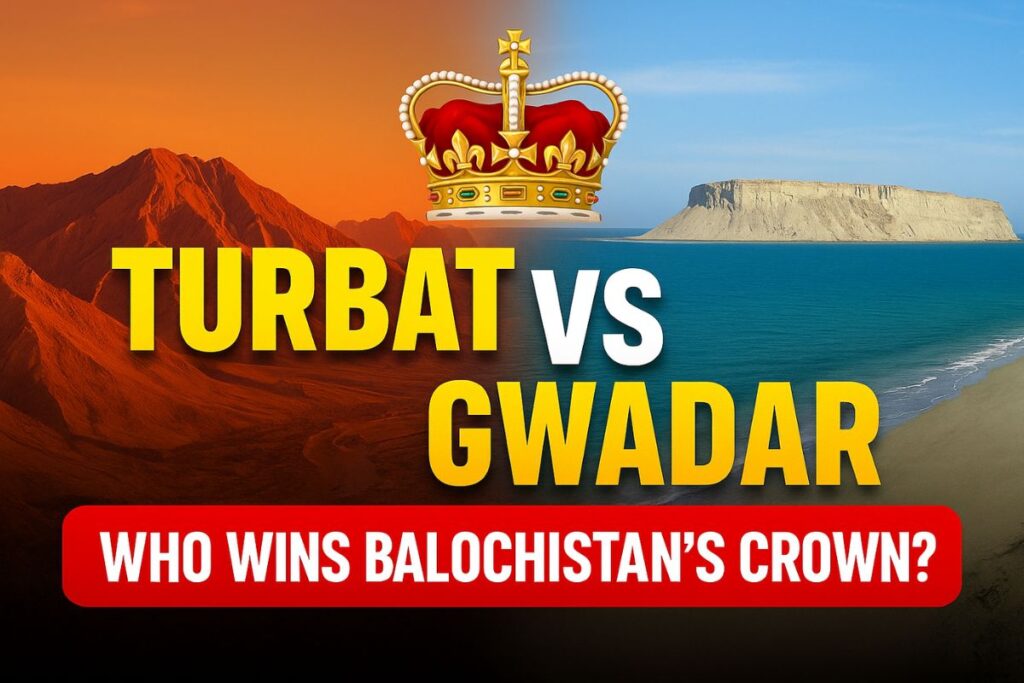
Balochistan, the largest province of Pakistan by area, is home to two of its most prominent cities – Turbat and Gwadar. Each of these cities has its own charm, history, and cultural significance. But when it comes to comparing them on various fronts like education, businesses, population, literature, diaspora, literacy rate, and influential personalities, which one stands out? Let’s take a deep dive.
Population: The Size and Diversity
- Turbat (Kech District): With a population of around 909,116, Turbat is the largest city in Kech District and the second-most populous city in Balochistan. It serves as the administrative center of Kech District and is known for its agricultural economy, especially date farming.
- Gwadar (Gwadar District): With a population of around 263,514, Gwadar is the main city of Gwadar District. It is rapidly developing due to the China-Pakistan Economic Corridor (CPEC) and is famous for its strategic deep-sea port.
Educational Excellence: Institutions and Literacy
- Turbat: Turbat has a literacy rate of 63.65%, the highest in Kech District and well above the provincial average of 58.7%. The city is home to the University of Turbat, Balochistan Residential College, OPF Public School Turbat, Cadet College Turbat, Atta Shad Degree College, Makran Medical College and other institutions offering affordable education.
- Gwadar: While Gwadar’s literacy rate is lower, it is home to institutions like the University of Gwadar, Gwadar Institute of Technology, GDA School And College and Pak-China Institute Gwadar. These institutions focus on technical and vocational training, aligning with Gwadar’s economic focus.
Departments and Business Opportunities
- Turbat: Known for agriculture, especially date farming and livestock, Turbat also has a growing educational sector with its university and training centers. Small businesses thrive in the city’s markets and the cost of living is relatively low.
- Gwadar: Gwadar is a hub for international trade and business due to its port. Real estate, logistics, fisheries, and international trade are booming here, with new businesses constantly emerging due to CPEC’s influence.
Literature and Cultural Richness
- Turbat: Known for its rich literary tradition, Turbat has produced legendary poets like Mullah Fazul, Atha Shad, Basheer Bedar, Ghulam Hussain Shohaz, Manzoor Bismil, Alijan Dad, Dr. Fazal Khaliq, Shareef Wahag, Ghulam Mohammad Baloch, Majeed Ajiz, Nisar Yousuf, Gul Mohammad Wafa, Ahog Gul, Nasir Basheer, Nazeer Nasir, Liaquat Amin, Irshad Parwaz, Rashid Deedar, Khalid Ars, Fazal Hayat, Saleem Sabit, Arif Aziz, Mumtaz Yousuf, Nadeem Akram and a remarkable number of female poets including Andlaib Gichki and Mehlab Naseer.
- Gwadar: While Gwadar may be more modern in its focus, it also has a notable literary presence. Sayad Hashmi, Abdul Majeed Gwadari, GR Mullah, Munir Momin, Anwer Sahib Khan, Mujeeb Mujahid, Zubair Mukhtar, Fareed Faraq, Abdullah Rahi, Doli Baig, Zamin Murad, Sajid Noor, Bahar Ali Gohar, Ejaz Bazzag, Saleh Mohammad Saleh, Shah ibne Sheen, Noon Meem Gul, Ahsan Mohammadi, Meer Umar Meer and AR Dad are among its celebrated poets and writers, while “Shaher-e-Ashob” Waja Mubarek Qazi is a prominent figure from Pasni, known as the “Lucknow of Balochistan” for its literary heritage.
The Diaspora: Global Presence
- Turbat: Many residents of Turbat have migrated to Gulf countries for work, sending back remittances that boost the local economy. The Turbat diaspora is well-represented in Middle East and Western Countries.
- Gwadar: Gwadar’s diaspora is similarly spread across the Gulf and beyond, often involved in business and trade due to the city’s focus on international commerce.
Influential Personalities
- Turbat: The city has produced a long list of influential figures, musicians like Ustad Khalil Ronaq and Mujahid Ghulam, singers like Sabzal Samigi, Shahjan Dawoodi, Muslim Hammal, Sabir Baloch, Nabeel Qadir, Wahab Baloch and Waris Bizanjo, Actors like Homer Kiyya and Hafeez Lal, Artists like Shaheena Shaheen and authors like Haneef Shareef, Gafoor Shad and Ghani Parwaz. Prominent singers Arif Baloch and Minhaj Mukhtar, known for their soulful Balochi music, also hail from Turbat, making the city a cultural hub.
- Gwadar: Gwadar is known for its icons like Ustad Jummah Khan, Rasool Baksh Fareed and Ustad Ejaz Ali in music, actors like Allah Baksh Haleef and Sarfraz Mohammad, Naseer Baloch, Khair Jan Baqri, Shoukat Safar, Khalil Sohrabi, Adil Shohaz, Hameed Gwadari, Gulab Jummah, Hamid Khaliq, Saleem Amin and Kamran Dad in singing. Another, Prominent Baloch Singer Noorkhan Bizanjo is From Pasni tehsil of Gwadar. These individuals have significantly shaped the city’s cultural identity.
Infrastructure and Development
- Turbat: Turbat is gradually developing and a model city of Balochistan, with its own international airport, expanding road networks,health facilities and improved educational facilities. It remains a city rooted in agriculture but is slowly embracing modern development.
- Gwadar: As part of the CPEC initiative, Gwadar is undergoing rapid transformation. With a deep-sea port, an international airport under construction, and extensive road networks, it is becoming a key economic hub for Pakistan.
Which City Has the Best Things?
- For Education and Literature: Turbat takes the lead with its higher literacy rate, established universities, and rich literary history.
- For Business and Economic Growth: Gwadar is the clear winner, with its strategic port and booming trade industry.
- For Cultural Legacy: Turbat is unmatched in poetry, literature, Baloch Politics and music.
In the end, the choice between Turbat and Gwadar depends on what you value more. Turbat offers a rich cultural and educational experience, while Gwadar is a gateway to international trade and economic opportunity.
FAQ
Q: What is the distance from Turbat to Quetta?
The driving distance between Turbat and Quetta is approximately 749 kilometers (465 miles), taking around 10 hours and 47 minutes by car. The straight-line (air) distance is about 607 kilometers (377 miles).
Q: What is the distance from Turbat to Gwadar?
The air distance between Turbat and Gwadar is approximately 122 kilometers (76 miles), while the driving distance is about 234 kilometers (145 miles).
Q: What is the distance from Turbat to Panjgur?
The driving distance from Turbat to Panjgur is approximately 283 kilometers (176 miles), with an estimated travel time of about 4 hours.
Q: What is the University of Turbat?
The University of Turbat (UoT) is a public university established in 2012, located in Turbat, Balochistan, Pakistan. It aims to provide higher education opportunities to students in the Mekran region, including Turbat, Panjgur, Gwadar, and Awaran. The university offers various undergraduate and postgraduate programs across multiple disciplines.
Q: What does ‘Turbat’ mean?
In Persian and Urdu, ‘Turbat’ (تربت) refers to a grave or tomb. The term is often used to denote a burial place or sepulcher.
Q: What is Gwadar Port?
Gwadar Port is a deep-water seaport located in Gwadar, Balochistan, Pakistan, on the Arabian Sea. It is a significant component of the China-Pakistan Economic Corridor (CPEC) and serves as a strategic hub for trade and economic activities.
Q: Where can I find a map of Gwadar?
Maps of Gwadar, including its master plan and development projects, can be found on various real estate and governmental websites. These maps provide detailed layouts of the city’s infrastructure, zoning, and planned developments.
Q: What is the history of Gwadar Port?
Historically, Gwadar belongs to Balochistan because it was governed by the State of Kalat, led by the Khan of Kalat. Due to strong historical ties and family relations between Baloch and Arabs, the Baloch people leased Gwadar to Oman. Even today, a significant Baloch population lives in Oman, which is clear evidence of their deep rooted relationship. The port’s potential was recognized in 1954, but significant development began in the early 2000s, with the port inaugurated in 2007.
Q: Where is Gwadar Port located?
Gwadar Port is situated on the southwestern coast of Pakistan, in the city of Gwadar, Balochistan province. It lies on the Arabian Sea, near the strategic Strait of Hormuz, and is approximately 533 kilometers from Karachi.
Q: When was Gwadar purchased from Oman?
Gwadar belonged to the State of Kalat for centuries and the Baloch people had leased it to Oman, where it remained under Omani Control for about 170 years. After Balochistan joined Pakistan, then the Minister of Defense Nawab Akbar Khan Bugti, using his Baloch-Oman Connections, managed to bring Gwadar and its port back on 8th September 1958 for approximately 3 Million USD.
Q: What is the importance of Gwadar Port?
Gwadar Port holds strategic significance due to its location near key oil shipping lanes and its role in the China-Pakistan Economic Corridor (CPEC). It provides Pakistan with direct access to global sea trade routes, reducing dependency on other ports and serving as a gateway for trade with Central Asia and the Middle East.
References:
https://en.wikipedia.org/wiki/Turbat
https://en.wikipedia.org/wiki/Gwadar
https://thediplomat.com/2025/02/gwadar-book-festival-a-literary-call-to-action-amid-climate-crisis
http://baask.com/diwwan
https://tribune.com.pk/story/2415499/an-oasis-for-bibliophiles-in-turbat
https://solutionsandinfo.com/7-cities-you-never-travel-before/

Turbat is the second largest city of balochistan and And we Promote Turbat and has Always Support for Turbat
Thank you, my friend. Please share the beauty of your city with your other friends as well.